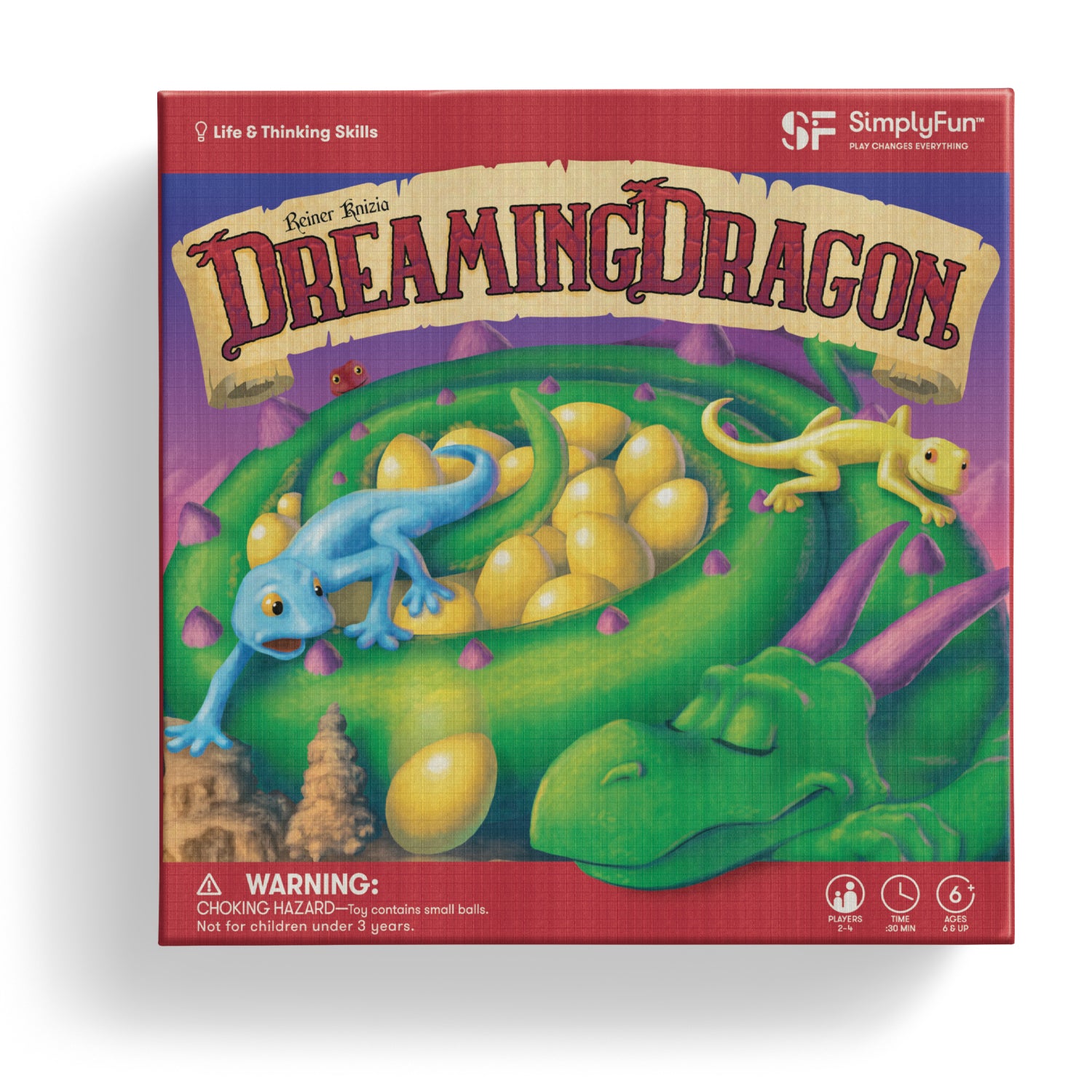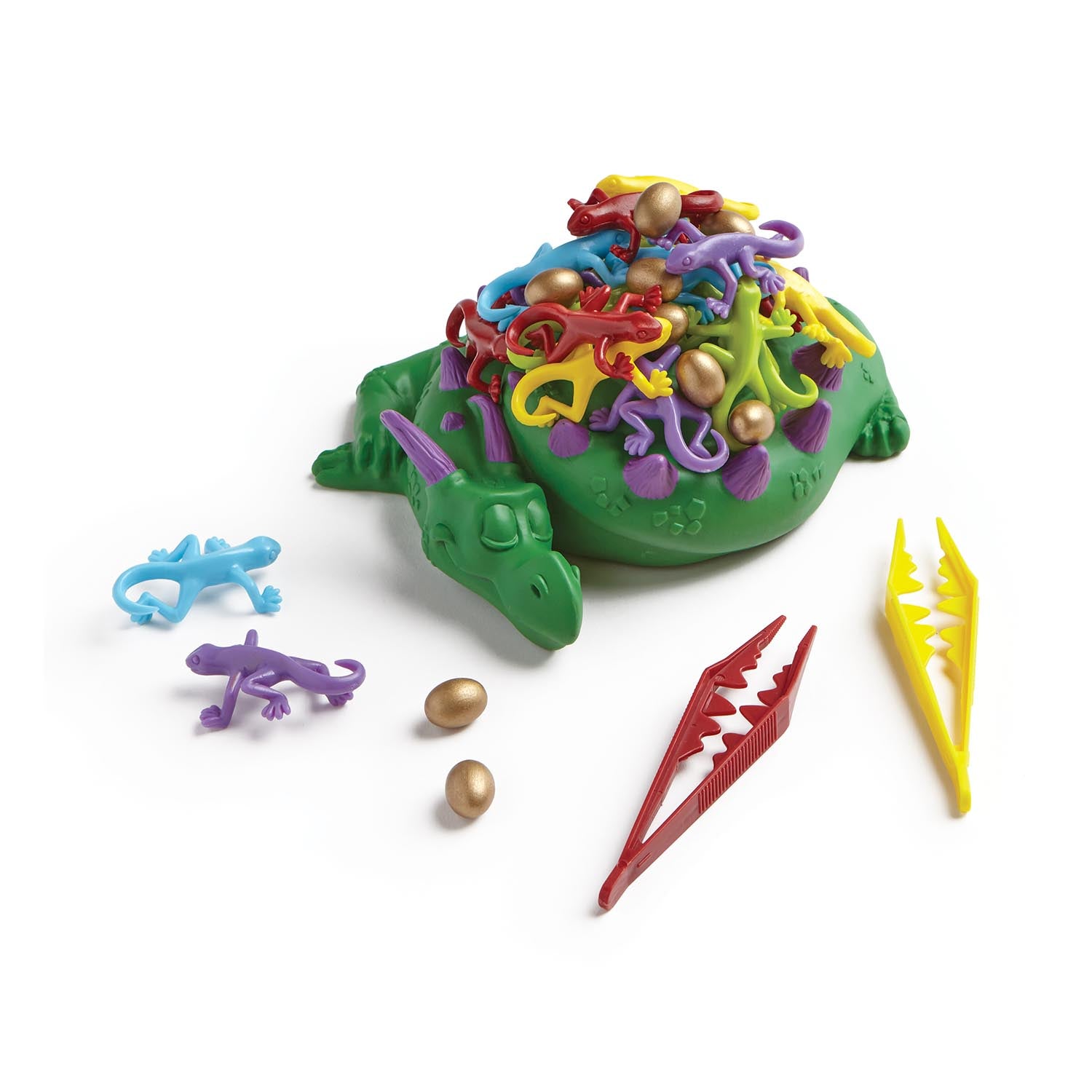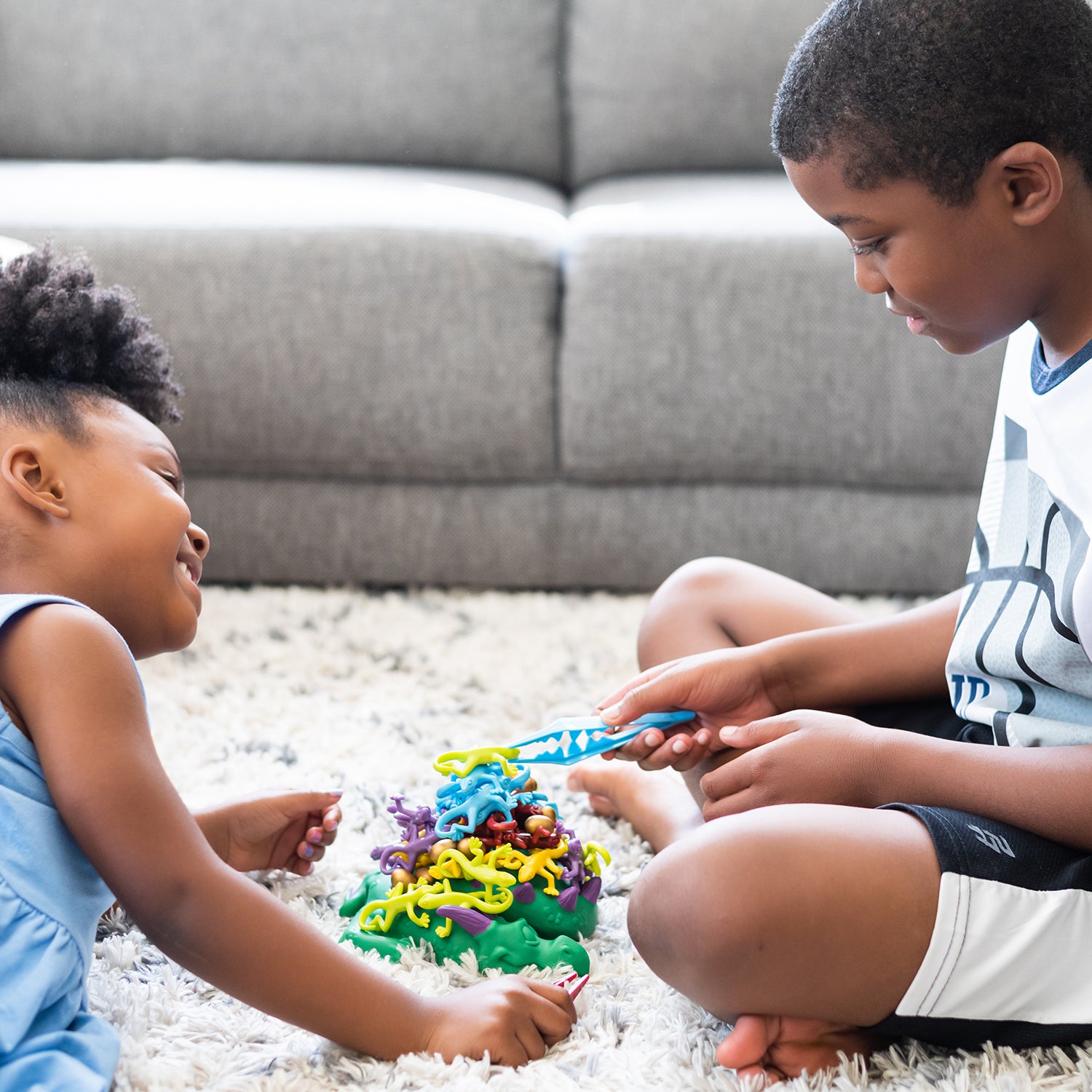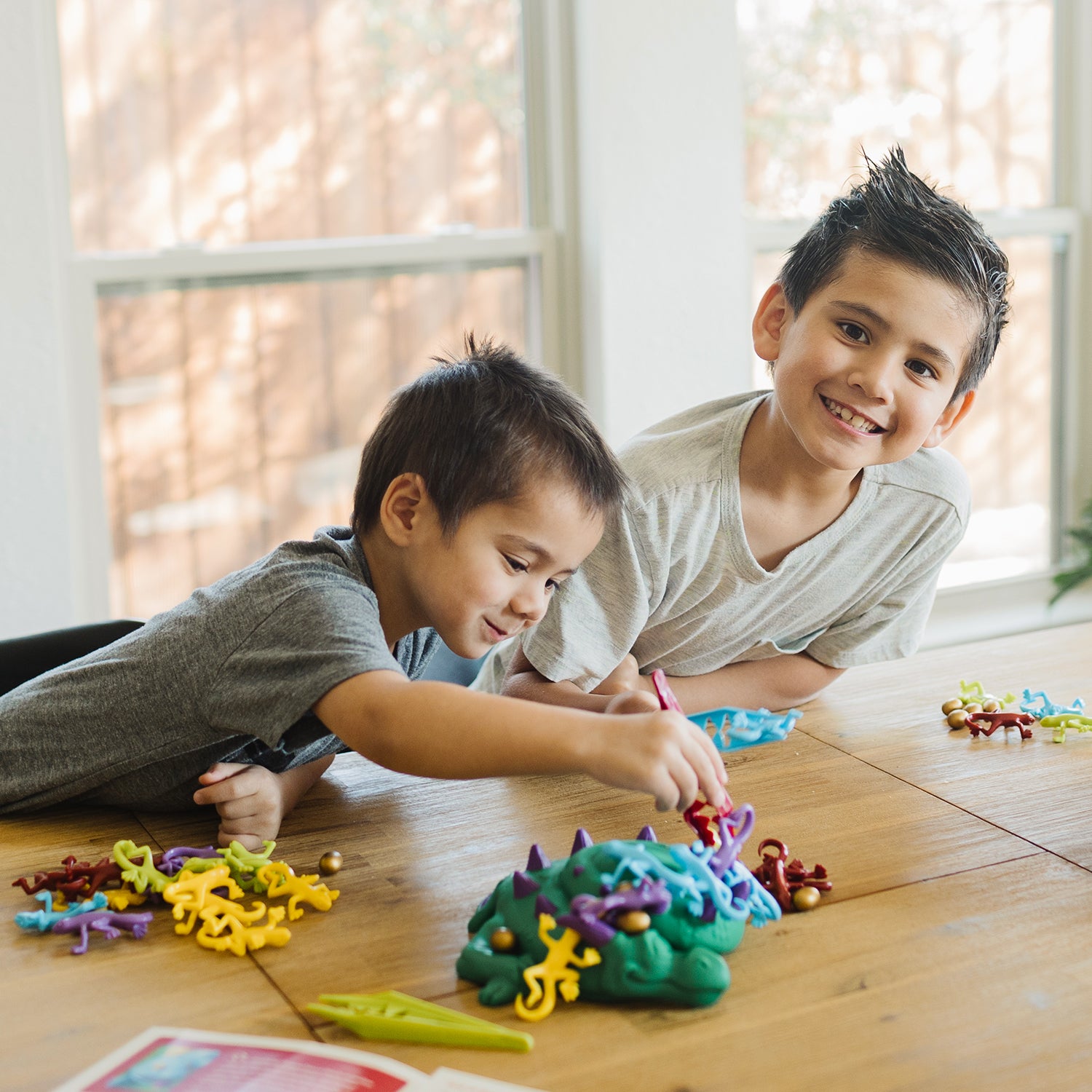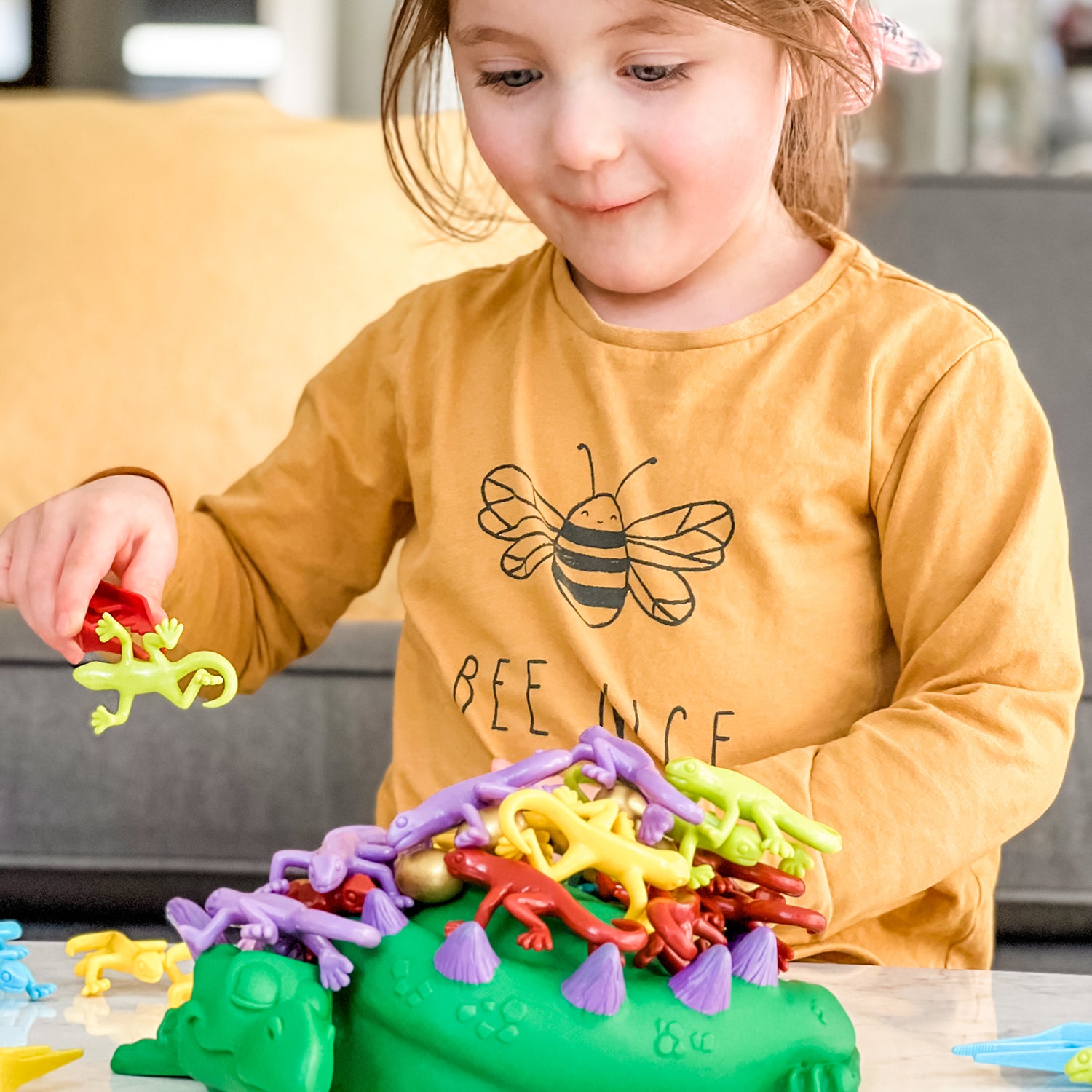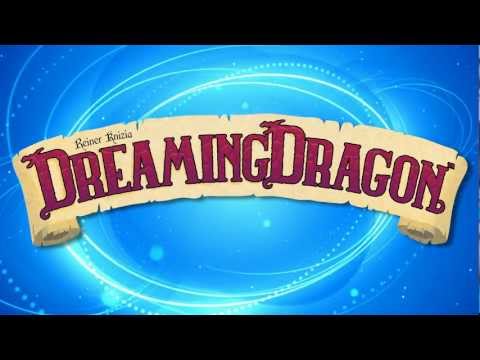Dreaming Dragon
Dreaming Dragon
2-4 players • 30 min • 6 & up
Focus: Fine Motor
Couldn't load pickup availability
Some sneaky lizards have found their way into a dragon's nest. Use your steady hand to help them escape without breaking the eggs or waking the dragon!
Skills: Focus & Self Control, Spatial Reasoning, Fine Motor Skills
Game Includes
Game Includes
- 1 Sleeping Dragon
- 15 Golden Eggs
- 29 Lizards
- 4 Pinchers
- 1 Rules Booklet
Share
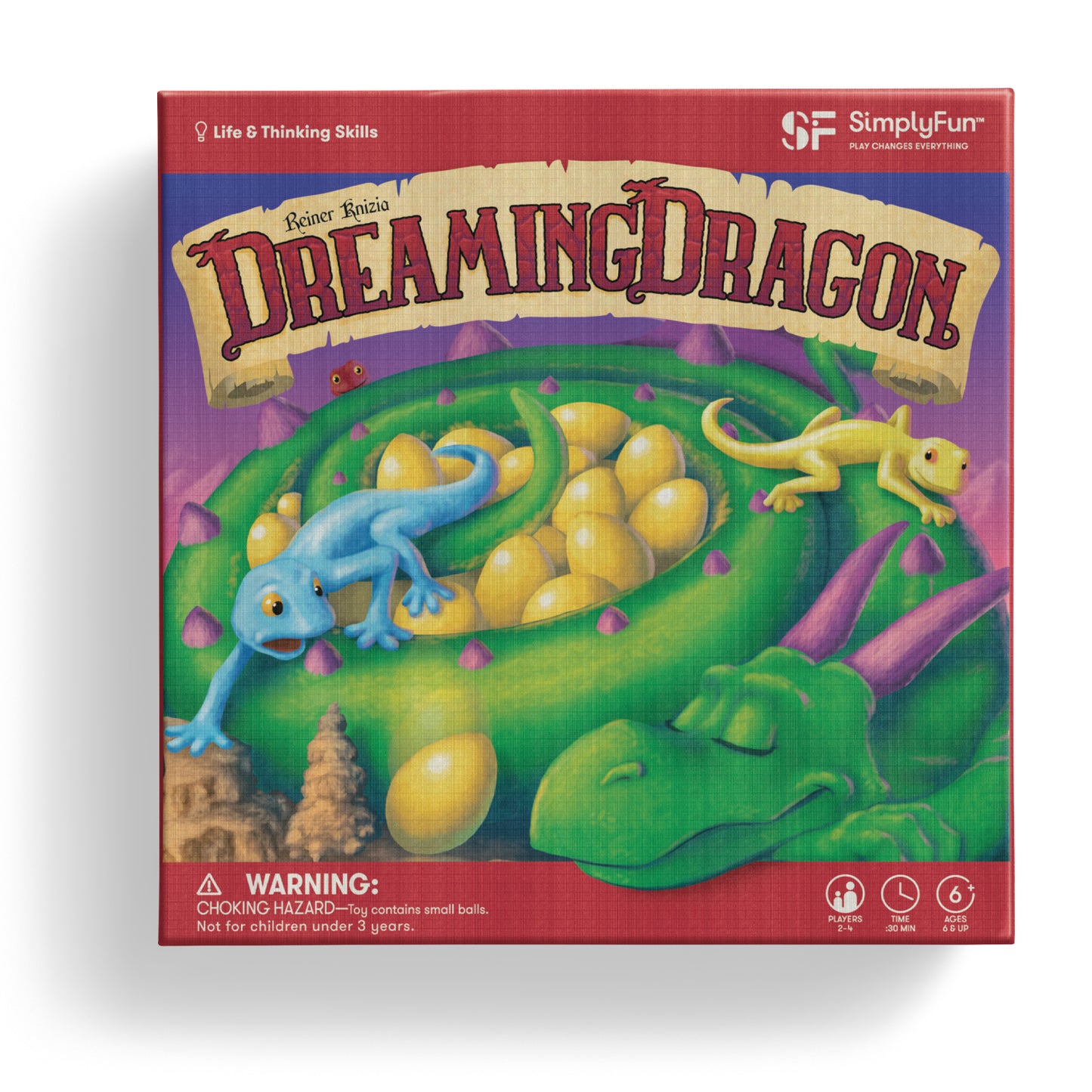
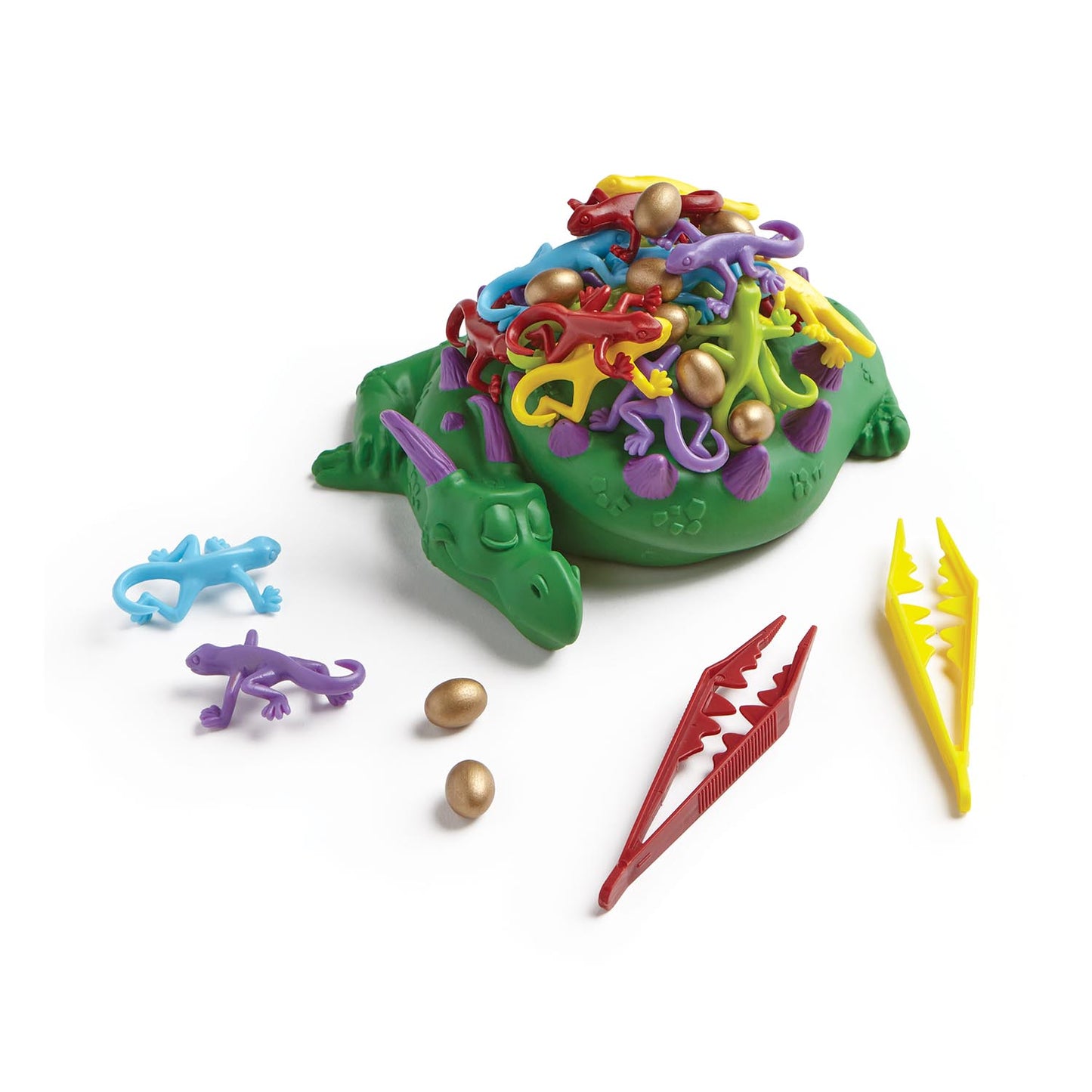
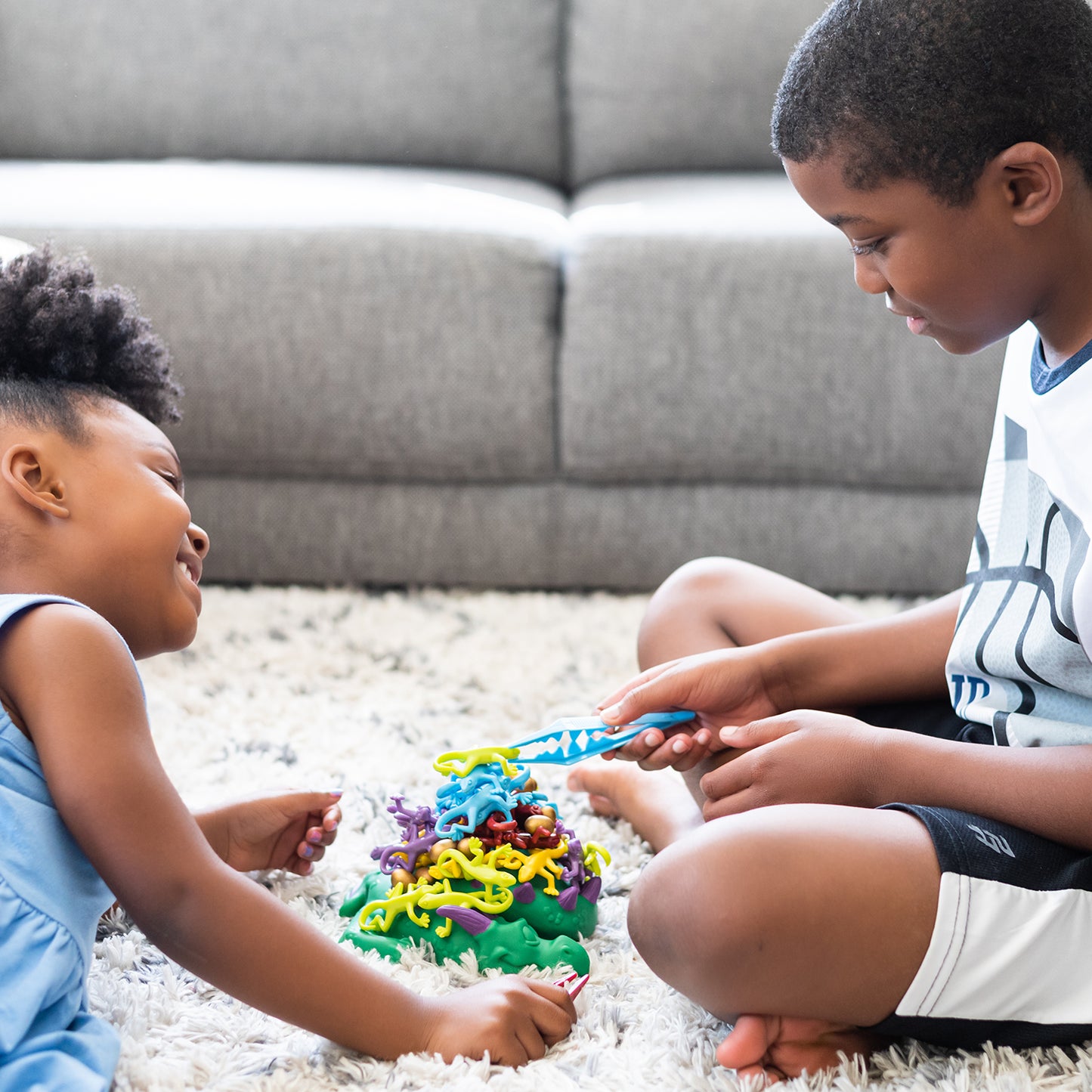
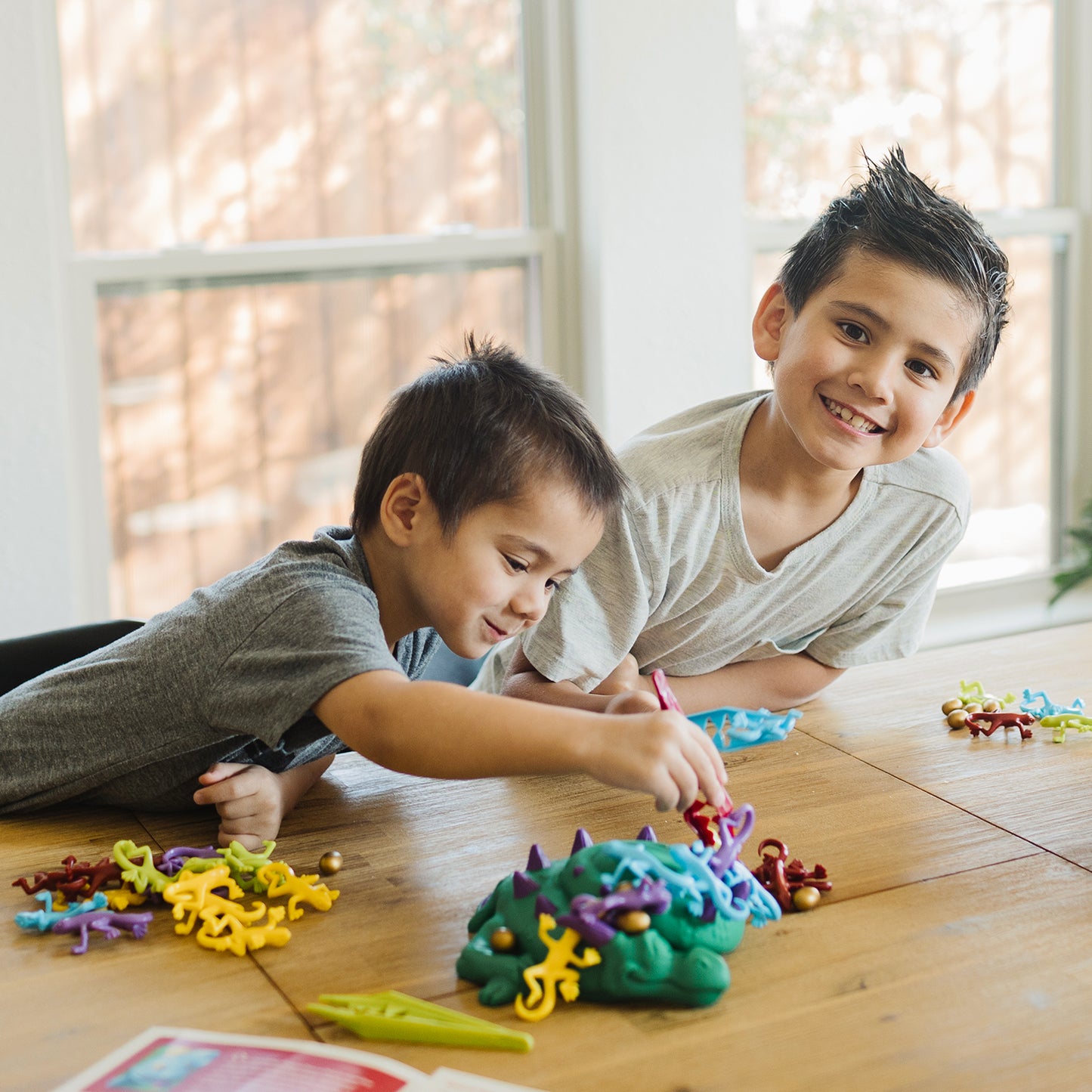
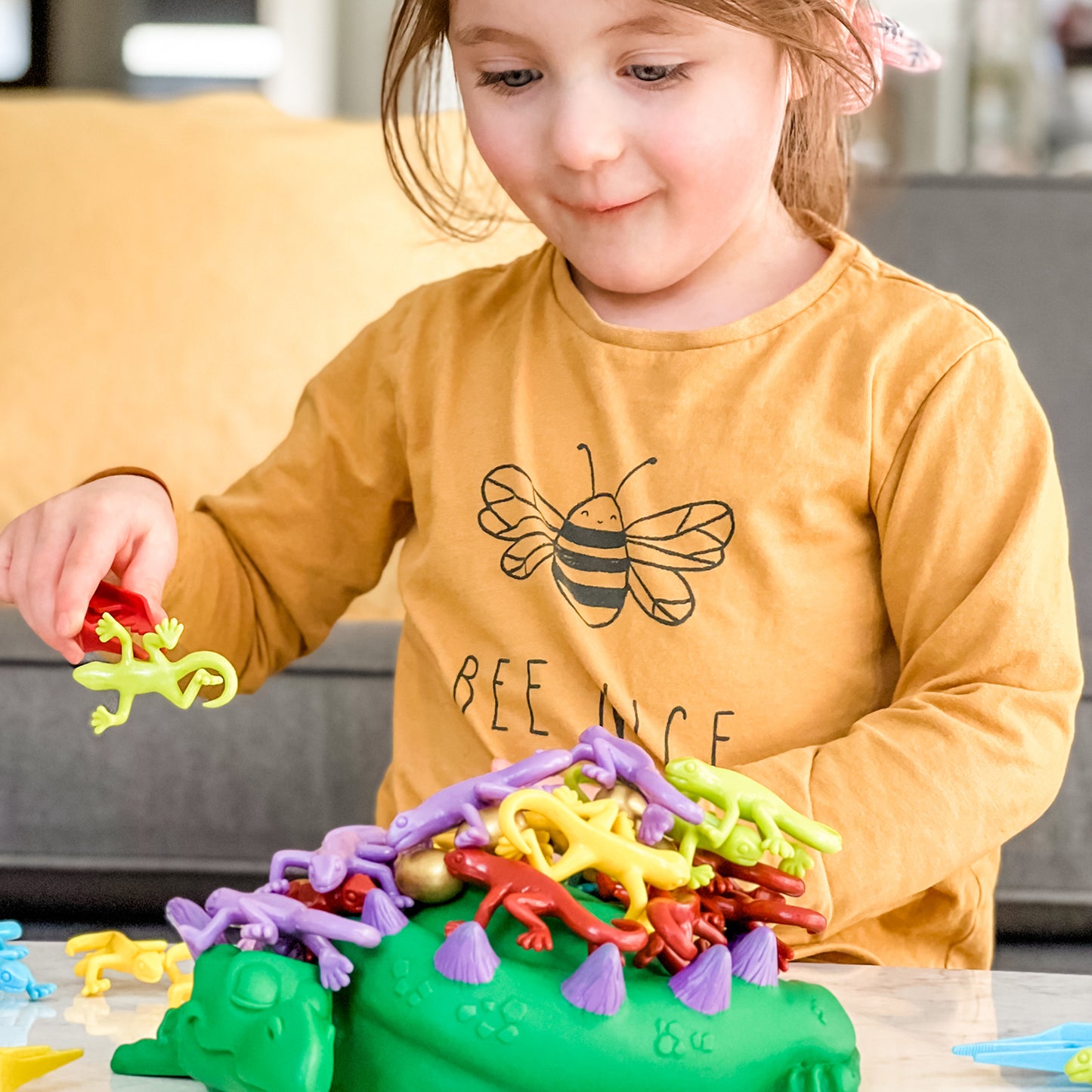



Collapsible content
How to Play
Educational Standards
Core Standard* Math, Science
Math
- Operations and Algebraic Thinking
- Understand addition as putting together and adding to, and understand subtraction as taking apart and taking from. Grade Levels K Represent and solve problems involving addition and subtraction. Grade Levels K, 1st, 2nd
Science
- Inquiry
- Making Observations. Grade Level Grade Levels K, 1st
- Application
- Tools and Materials. Grade Level K
Skills
Explore
What Does Child Do To Use Skill In The Game?
The game requires players to examine how eggs and lizards are placed in relation to each other and pick an option likely to result in obtaining a lizard without letting an egg fall.
How Parents Can Assist Learning
Parents can ask children to walk around the dragon and look for where lizards are not touching an egg or hooked to a lizard that is touching an egg. This teaches children to explore and think before acting.
Learning Implications and Educator Support
This game helps children think about inter-relationship among parts. How does one thing I do result in something I do not expect. Many fine motor games, including construction and puzzle solving require this type of study. Educators can encourage children to think about various aspects: placement of eggs, position of lizards to each other, carefulness of movement, etc. Ask them to explore the game set up before playing.
Determine
What Does Child Do To Use Skill In The Game?
Players must analyze position of lizards and eggs, connection of the lizards, and likelihood of successful retrieval. Players may be thinking, "I'll try this lizard instead of the areas where more eggs could fall."
How Parents Can Assist Learning
Parents can encourage children to determine the best option for a given play. Encourage study before acting.
Learning Implications and Educator Support
Strategy games or activities that require anticipation of consequences all require analysis of the specific aspects of the situation. Educators can encourage looking at more than one spot before determining which lizard to select.
Compare
What Does Child Do To Use Skill In The Game?
Players will compare what worked and didn't work on each turn and begin to modify their approach. Parents can verbalize what they saw in each player's turn. For example, Maisie found a lizard that was hooked to another lizard and got two lizards. I tried that too, but my second lizard was touching an egg, so the egg fell.
How Parents Can Assist Learning
Parents can encourage children to compare their actions to determine what was successful. Why did an egg fall or not fall on the previous turn.
Learning Implications and Educator Support
Educators can ask children to discuss why a move worked or didn't, and how one move was similar or different than another.
Remember
What Does Child Do To Use Skill In The Game?
Memory of successes and failures will help players develop more successful strategies. Player may be thinking, "I need to look at where the eggs just fell, so I can see if there are lizards without any eggs now."
How Parents Can Assist Learning
Personal experience of success or failure reinforces what to do or not do in future situations. These experiences may generalize to other games and situations. Especially when children make a mistake, adults can ask them to remember the turn where they had more success. "What did you do then?"
Learning Implications and Educator Support
Personal experience of success or failure reinforces what to do or not do in future situations. These experiences may generalize to other games and situations. Especially when children make a mistake, adults can ask them to remember the turn where they had more success. "What did you do then?"
Predict
What Does Child Do To Use Skill In The Game?
With experience with the game, players will be able to predict the likelihood of success on any particular turn. Parents can ask children to predict what will happen on their turn. This will help children think more carefully and be less impulsive.
How Parents Can Assist Learning
The experience with this game may help children think ahead and be more cautious before acting. This is particularly true if adults reinforce the learning. For example, "Remember what happens if you don't think ahead. Your golden egg falls."
Learning Implications and Educator Support
With experience with the game, players will be able to predict the likelihood of success on any particular turn. Educators can ask children to predict what will happen on each turn. This will help children think more carefully and be less impulsive.
Plan
What Does Child Do To Use Skill In The Game?
Parents can encourage children to watch what other players do, analyze the result, survey the options, and plan their next move. "There are still lots of lizards left. I need to take my time and look for the best spot."
How Parents Can Assist Learning
This teaches children to take their time and make a plan. Parents can encourage children to take their time, look over the whole dragon, and make a plan for what they will do.
Learning Implications and Educator Support
Children will often have their eye on a lizard they want to get in the next turn, only to have another player retrieve it first. Educators can encourage children to think of more than one option for their next turn. This will build foresight and confidence.
Experiment
What Does Child Do To Use Skill In The Game?
Each turn gives the player a chance to try a different approach, such as move slowly, move quickly, pull out the end first, and find an area with no eggs.
How Parents Can Assist Learning
Children who try different approaches and find what works are more successful than children who are impulsive. Parents can reinforce children's efforts to try something different when the previous approach failed. Prior to playing "for real," parents can let kids try different moves with a "practice dragon."
Learning Implications and Educator Support
Children who try different approaches and find what works are more successful than children who are impulsive. Educators can reinforce children's efforts to try something different when the previous approach failed. Prior to playing "for real," educators can let kids try different moves with a "practice dragon."
Practice
What Does Child Do To Use Skill In The Game?
Each turn gives players practice with their strategies.
How Parents Can Assist Learning
Leave the dragon, lizards, and tongs out for practice. Children will see the "loaded" dragon and won't be able to ignore it. The dragon will draw them in for practice!
Learning Implications and Educator Support
Practice is needed to learn any skill. Educators can reinforce the child's increasing skill, such as for seeing where to try to get a lizard, using the tongs, or being careful in their approach. This is a game that can be left as part of a classroom play center (such as construction) for children to construct and de-construct at will.
Solve
What Does Child Do To Use Skill In The Game?
After several turns the player will be better able to analyze the dragon and choose a place to play. With practice players will conclude that if the eggs are touching any of the lizards they are trying to retrieve the egg will be moved.
How Parents Can Assist Learning
Parents can comment on various aspects of each turn to help children focus on different aspects. For instance, "Move v-e-r-y s-l-o-w-l-y!" Or, "If you tip the lizard backwards as you slowly pull it out, the egg may fall on the lizard behind it." Giving tips may help children think of strategies they had not considered.
Learning Implications and Educator Support
This game encourages children to be persistent in their efforts. Drawing conclusions from several tries is important, but doesn't always happen naturally. Educators can help children see what worked by asking questions or by making comments, such as "When you got the lizard before you pulled his tail out from below the lizard above. Will that work now?" Educators should comment on children's persistence and their efforts to try to solve the problem. They can also encourage them to help each other with ideas and encouragement.
Review
What Does Child Do To Use Skill In The Game?
Good players will think back on what they tried in previous turns. A player might think, "A couple of turns ago I saw two eggs together and only paid attention to one."
How Parents Can Assist Learning
Reviewing previous actions is important for learning. Parents can ask children to think about what they did before. "What do you need to think about?" "Why did that work so well?" "Tell us how you did that?"
Learning Implications and Educator Support
Reviewing previous actions is important for learning. Educators can ask children to think about what they did before. "What do you need to think about?" "Why did that work so well?" "Tell us how you did that?"
Demonstrate
What Does Child Do To Use Skill In The Game?
Players will begin to anticipate what will happen to other players in their moves. ("Don't try it!")
How Parents Can Assist Learning
A great way to support children is to say, "Show me how you did that! You were great!" Children love to show off their skills. Demonstrating or verbalizing what they did makes children evaluate what worked.
Learning Implications and Educator Support
Learning to be a leader involves learning how to support others. Educators can encourage children to share what they are learning with others. A child might say, "I'll try this instead of the areas where more eggs could fall." in order to show other children how to successfully get a Dragon.
*Data compiled from CCSSI ELA Standards, WA Science Standards, and Washington Social Studies Standards
Special Needs
Cognitive
Suggestions for How to Modify Play Experience
Use fewer eggs so the child has more chance for success and can count more easily.
Use fewer lizards so they are easier to pick up, and the child can have early success.
Show children how to line up the lizards as they come off the dragon. Also, line up the eggs underneath the lizards. This provides organization so the child can see the relationship.
Communication
Suggestions for How to Modify Play Experience
Start with two eggs on the pile of lizards. Give instructions slowly, so the child can understand. After the first lizard is retrieved continue slowly until an egg falls. Add two more eggs and proceed. Keep adding eggs as the child comprehends the process. Then play as intended.
Ask the child to verbalize what they are doing to practice using action words and prepositions.
Sensorimotor
Suggestions for How to Modify Play Experience
Use fewer lizards and eggs. Let children use their fingers first, so they understand how to pick up a lizard without the egg falling.
Move to using tweezers when the child can successfully pick up a lizard with fingers. Add a few more lizards to increase the need for the tweezers.
Social Emotional/Behavioral
Suggestions for How to Modify Play Experience
Use a flashlight and shine it on an area where the child can try to pick up a lizard. This will help the child focus.
Use verbal prompts in a soft, slow voice to prompt slow movements.
Ask the child to verbalize what they are doing. For example, "Tell me what you are doing as you do it, so I can learn how you do it." This will help the child focus and be less impulsive.
Vision
Suggestions for How to Modify Play Experience
If child has some vision, place one egg at a time and use a magnifying glass while picking up the lizards.
Describe what is on the card and let children with vision concerns use the verbal cues as a stimulus for their story.
Hearing
Suggestions for How to Modify Play Experience
Model how to do the game before starting. Start with fewer eggs and lizards. Line up the lizards that you retrieved and count them. Line up the eggs that fell under the lizards. Remove each egg with a lizard. Count and write down the total number of lizards left. Show the child the number and give a "thumbs up" to indicate this is good. Then put all of the lizards and eggs out and model the increased difficulty.
*Data compiled from CCSSI ELA Standards, WA Science Standards, and Washington Social Studies Standards
Autism
Autism Strengths & Interests
Short Summary of Strengths & Interests
- Good at spatial reasoning as they decide which lizard to move
- Enjoys fine motor activities, including playing with tweezers.
- Likes to analyze situations.
Is good at matching visual items
This game is not appropriate
Has a good memory for sensory details, including visual, touch, taste and smell
Is This Game Appropriate? Yes
Description
Children may enjoy several sensory aspects of Dreaming Dragons, including, putting all of the lizards and eggs on the dragon, the feel of the squishy lizards and smooth eggs and the sound of the eggs hitting the table top. Also, the more children play, the more adept they will become in using the pinchers to move a lizard without knocking anything else off of the dragon's back.
Has a good memory for words, phrases and dialouge
This game is not appropriate
Has a good memory for pictures, numbers and patterns
This game is not appropriate
Likes to put things in order or a sequence
This game is not appropriate
Learns through visualizing or "replaying" actions in their mind
Is This Game Appropriate? Yes
Description
Children will be able to determine which lizard to move by visualizing what may happen if they try to move the different available lizards. The ability to make the best choice will also involve visualizing what has happened on prior turns, such as eggs or lizards moving and becoming more likely to fall or remain.
Likes activities with rules, such as math and phonics
This game is not appropriate
Is very concrete and literal
Is This Game Appropriate? Yes
Description
Dreaming Dragons is a very clear cause and effect game. Namely, move a lizard successfully, or move it and cause eggs or lizards to fall off of the dragon's back. Children who enjoy concrete, clear activities will find this game a good match.
Learns in small "chunks" (for example, phone numbers are 3 chunks of number xxx-xxx-xxxx that are combined together)
This game is not appropriate
Is good at nonverbal reasoning and logic
Is This Game Appropriate? Yes
Description
Some children are good at logic and reasoning, but do not like to discuss or verbalize their thinking. Dreaming Dragon is a good match for these children, since players demonstrate their reasoning through action. Namely, they pick up the lizard they think is least likely to cause other lizards or eggs to fall.
Likes spatial problem solving
Is This Game Appropriate? Yes
Description
Children with autism who are good a spatial problem solving can use that skill to do well at Dreaming Dragon. On their turn, children need to examine all the lizards and eggs, thinking three-dimensionally about how pieces are interconnected. Ultimately, they will select a lizard to remove. Hopefully, they do not knock down any eggs!
Can read well with good vocabulary, though may not fully comprehend content
This game is not appropriate
Likes to use and has good fine motor skill
Is This Game Appropriate? Yes
Description
Dreaming Dragons involves a high degree of fine motor skills as players use pinchers to gently remove a lizard, which may be intertwined with other lizards to touching an egg. For children who enjoy using their hands and small tools, Dreaming Dragon is a great game to show off and refine those skills.
Likes established routines or set ways of doing things
This game is not appropriate
Likes manipulating, constructing or building things
This game is not appropriate
Likes to use and has good musical abilities
This game is not appropriate
Likes to use and has good drawing skills
This game is not appropriate
Autism Special Considerations
Appears to ignore other's communication and/or has difficulty giving eye contact to a communication partner
Is This Game Appropriate for Child with Characteristic? Yes
Can Child with Characteristic Play Game w/o Modification? Yes
Strategies for Developing Compensatory Skills:
Sit or stand at an angle to the child, so direct eye contact is not needed.
Look at the game instead of each other.
Person talking holds the object being talked about near their mouth to bring the child's attention to the object. This also shows the child how the words about the object are produced. For example, hold two lizards by the mouth and say," I have two!"
Rather than speak, sing communication between turns or when giving short directions. Music attracts the child's attention and interest. Use unusual or exaggerated inflection to begin a communication about the game. This attracts the child's attention.
Has difficulty understanding complex verbal directions
Is This Game Appropriate for Child with Characteristic? Yes
Can Child with Characteristic Play Game w/o Modification? Yes
Strategies for Developing Compensatory Skills:
Combine short verbal instructions with visual and physical examples of each step. For example, first illustrate what happens when a dragon is obtained without dropping an egg. Then demonstrate what happens when eggs fall.
Use hand-over hand guidance if needed, so children feel the actions as the directions are being given. This helps develop the child's memory for the correct movements. Gradually reduce the support as the game is learned.
Check for comprehension by asking the child to demonstrate what they need to do.
Let children read the directions as they are explained. Visualizing the words is often a stronger learning method for children with autism.
Uses vocabulary inaccurately or demonstrates echolalia (repeating another's speech)
Is This Game Appropriate for Child with Characteristic? Yes
Can Child with Characteristic Play Game w/o Modification? Yes
Strategies for Developing Compensatory Skills:
Respond to immediate echolalia (repeating what was just said) by rephrasing the child's response into a correct format, so the child can hear and repeat that phrase. For example, assume you are playing with a child named Andy and you say, "Your turn," and Andy repeats, "Your turn." You can say, "It's Andy's turn. You say, my turn." This allows the child to hear and repeat the correct response. Eventually, the child will pick up the pattern of response.
Delayed echolalia (repetition of previously heard comments) may have a hidden meaning or association. Look for connection in the phrase used to the current situation. For example, the child says, "After these messages we'll be right back!" Think what the repeated phrase is associated with for the child. Try to interpret what is meant and rephrase it for the child. For example, you might respond by saying, "It sounds like you want a break for a few minutes. Is that what you mean? You can tell me, 'I need a break.'"
Gets stuck repeating a verbal topic or physical actions and/or has difficulty attending to others' actions or topic.
Is This Game Appropriate for Child with Characteristic? Yes
Can Child with Characteristic Play Game w/o Modification? Yes
Strategies for Developing Compensatory Skills:
Incorporate a preferred topic into the game to increase motivation. For example, if the child is fixated on a particular character, like a favorite superhero, ask what the character would do if they were playing? For example, place an action figure of the favorite superhero on the number 50 and say, "You need to get the dog bone to [favorite superhero] so he can get it to Digger!"
Practice phrases for commenting on others' play actions. For example, you say to Joe (who is playing with you), "Right on! You got a total of 5 on that play ." Then ask the child, "What did Joe do? " Remind children about listening and watching others' before making their own comment or action.Practice turn-taking in conversation. Use a cue, such as a touch on the shoulder, if needed.
Use a motivation toy or object to gain the child's attention. For example, a preferred wind-up toy can be placed on the board when it is the child's turn. The child gets to wind up the toy after completing their turn.Use the child's finger to point to what needs attention. They attend to their finger first, and then the adult can point out the object he is pointing at.
Extend the child's action to make a correct response. For example, if the child gets stuck on always matching one color, the adult can say, "Try another color. Look at the triangles. Do they match anything?"Reinforce attention and actions by commenting on what was done correctly. For example, "I love how you looked carefully at the tile before placing it!"
Has difficulty producing speech/communication
Is This Game Appropriate for Child with Characteristic? Yes
Can Child with Characteristic Play Game w/o Modification? Yes
Strategies for Developing Compensatory Skills:
Use augmentative communication, such as picture cards. For example, a picture of person pointing to another person means "your turn."
Use gestures and sign language to illustrate actions or concepts. For example, use the sign for 'finished' (two hands facing down, spread out from the middle of the body), point to the next player and say, "I'm done. It's your turn." The signs and gestures add a visual component to support understanding.
Extend the child's sounds into words or words into phrases to provide a model. For example, if the child says, "If the child says, "Fall," say, "THREE eggs fell!" Provide at least 10 seconds wait time for the child to process or produce responses. It may take longer to formulate a thought or response for children with special needs.
Has difficulty sequencing multi-step actions and/or doing complex abstract tasks
Is This Game Appropriate for Child with Characteristic? Yes
Can Child with Characteristic Play Game w/o Modification? Yes
Strategies for Developing Compensatory Skills:
No complex steps are involved.
Demonstrates difficulty initiating and maintaining social interactions
Is This Game Appropriate for Child with Characteristic? Yes
Can Child with Characteristic Play Game w/o Modification? Yes
Strategies for Developing Compensatory Skills:
Develop a social story to be read at the start of a game. A social story is a short booklet that illustrates how a child can use positive social skills. It includes two to five descriptive statements and a directive statement. For example: "When I watch others, I will know when it is my turn. Others like me when I take turns. I will watch what others do with their pieces and listen to what they say. Others like it when I talk about the game." Add photos or drawings of the child doing the actions described in the story.
Role play social situations and reinforce appropriate words and actions. For example, role play finishing the game and congratulating the winner. Or, role play commenting on another player's turn. For instance, "Good play, Matt!"
Use video feedback of positive social behaviors. Video of actual play enables children to see what they or others did. Appropriate actions and interactions can then be discussed.
Acts out or demonstrates avoidance behaviors when frustrated, overwhelmed, or needs more sensory input.
Is This Game Appropriate for Child with Characteristic? Yes
Can Child with Characteristic Play Game w/o Modification? No
Strategies for Developing Compensatory Skills:
Reduce extraneous noise or allow the child to wear head phones or ear plugs if loud sounds cause anxiety.A weighted vest worn during the game may provide additional pressure input and thus reduce fidgeting due to sensory needs. Pressure can be calming when used for no more than 20 minutes at a time.
Practice a phrase to ask for help and role play situations in the game where it is needed.Provide techniques for self-calming, such as holding a special toy.
Allow time for movement. For example, a child who needs to move frequently can be given an opportunity to 'celebrate' their turn by running around the table or jumping up and down 10 times.
Has short attention span for non-preferred activities
Is This Game Appropriate for Child with Characteristic? Yes
Can Child with Characteristic Play Game w/o Modification? No
Strategies for Developing Compensatory Skills:
Provide a break when needed.
Use "when...then" phrases. For example, "When you take your turn, then I'll let you play with your toy."
Frequently remind the child of the goal of the game. "You want to get a big number when you add your symbols. Then you get to move your bone further!"
Incorporate a motivating activity as part of the play. For example, each player gets to manipulate a fun 'fidget' toy, such as a stress ball or squeeze toy.
Needs sameness or consistent routines and/or has difficulty with transitions from one activity to another
Is This Game Appropriate for Child with Characteristic? Yes
Can Child with Characteristic Play Game w/o Modification? Yes
Strategies for Developing Compensatory Skills:
Play games at the same time every day, so the child anticipates the game routine.
Change the location of the game, so the child may play in different rooms, at the table, or on the floor. This will build tolerance for variation.
Prepare the child ahead time for the introduction of a new game. Talk about aspects that will be motivating for the child, and let them explore the parts of the game before setting out the whole game. For example, examine the bones and tiles.
Provide a structure for placement of game pieces that can be the same each time the game is played. For example, have a specific location for where the board goes, the tiles, etc.
Provide choices for how the child can be involved in set up or clean up. For example, you might ask, " Do you want to pass out the bones or the tiles?" Involve the child verbally and with actions for the transition to the game table or at the end of game play. For example, you might say, "Let's look at the pictures on the game box and guess what it is about."
Use an object cue. Let the child hold an object from the game or activity you want to introduce prior to the transition. For example, if you were intending to play Digger's Garden you would hand the child a bone from the game and say, "Look here is a bone. Let's see what game we can play?"
Has difficulty understanding others' feelings, intentions, and the reasons for others' actions.
Is This Game Appropriate for Child with Characteristic? Yes
Can Child with Characteristic Play Game w/o Modification? Yes
Strategies for Developing Compensatory Skills:
Model and point out what others are feeling and comment on their facial expressions or words.Discuss what causes feelings in others. For example, "You are happy because you got to move your bone 5 steps. But, look at Joe's face. He is not happy because he only moved 2 places."
Ask child to explain their own feelings and intentions.
Ask child to explain why other players did specific actions in the game.
*Data compiled from CCSSI ELA Standards, WA Science Standards, and Washington Social Studies Standards
Extended Play
Extra Ways to Play the Game
Cook golden eggs to make breakfast for the King and Queen. Mom and Dad are King and Queen to be served "royal eggs" by the "royal chef." Make up a story about where the royal eggs came from. Do they have magical powers if you eat them? Or, even turn your story into a play with the magical eggs.
Materials Needed
Use pretend or real pots and pans and utensils for "cooking" the golden eggs from the game.
Developmental Benefits
This expansion builds children's imagination and creativity through dramatic play. Interaction with the parents can add language skills and practice of social conventions. Having the child develop a story line also builds the foundations of literacy.
Extra Ways to Play the Game
Spoon race with eggs. Use a teaspoon, place an egg it it, and let children race in a safe space. If egg spills, they start over. This can be a relay or group race to a finish line.
Materials Needed
Teaspoons and the golden eggs.
Developmental Benefits
Walking or running while carrying the egg in a teaspoon develops balance. The child also needs to think about two things at the same time, namely, running/walking (a gross motor task) and carrying (a fine motor task). This complicated task builds coordination.
Extra Ways to Play the Game
Use the pinchers to pick up and hook lizards together. Hold first lizard in one hand, use other hand to manipulate the pinchers and attach it to the previous lizard. See who can make the longest chain in one minute.
Materials Needed
Pinchers and lizards from the game.
Developmental Benefits
This expanded game helps children build the ability to use the eyes to guide the hands (eye-hand coordination) and bilateral (both sides of the body) coordination. The addition of timing adds tension to the game, thus, children need to employ impulse control to maintain their focus.
Extra Ways to Play the Game
Let children make a virtual "game board" path on the floor out of the lizards with the dragon at the end of the path. The lizards are the "spaces" on the game board. Use the eggs as the players' markers. Add one die or a spinner. Let children make up the rules for the game. For example, each colored lizard might have a meaning (Green means go forward one more. Purple means go forward two. Yellow means stay where you are. Red means go back one. Blue means go back two.) Children role the die to move forward. The first player to get their egg to the dragon at the end of the path wins. Have children make a chart, so they can remember the meaning of the colors. Green = +1, Purple = +2, etc.
Materials Needed
Lizards and golden eggs from the game. One die or a spinner from another game.
Developmental Benefits
Making up a game requires planning and working together to make up the rules. This builds cooperation and negotiation skills. Children can be creative by developing a story to go with the game they create. They also can build a winding path that could around a sofa, under a chair, etc. If they decide to assign a meaning to the color of the lizards they are engaging symbolic thinking and using memory skills. Having the game spread out on the floor uses both gross motor and fine motor skills. Parents may need to help children see how they can create a game on the floor, but once it is started the children will take over and make it their own!
*Data compiled from CCSSI ELA Standards, WA Science Standards, and Washington Social Studies Standards
Collapsible content
How to Play Video & Transcript
A game where you rescue lizards from the sleeping dragon’s nest without disturbing her eggs.
You can play Dreaming Dragon with 2-4 players, ages 6 and up.
Dreaming Dragon is good for developing Fine Motor Skills as players use their pincher tool with a steady hand to grab a lizard and lift it from the dragon’s back.
Dreaming Dragon also helps with Spatial Reasoning as players examine their options and choose the lizard that is least likely to disturb the eggs.
• Place the sleeping dragon in the middle of the play area.
• Place all 29 lizards on top of the dragon, and then carefully place up to 15 eggs on top of the lizards.
• Each player is given a pincher. Players try to collect as many lizards as possible from atop the sleeping dragon without causing any golden eggs to fall.
On your turn, use your pincher to remove one of the lizards from the dragon.
If you are successful, place the lizard in front of you.
Any other lizards that are attached to the one you remove are also placed in front of you.
If any lizards or eggs fall off the dragon during your attempt, your turn ends.
You may keep any lizards that are still attached to your pincher but must also keep any eggs that have fallen during your turn.
After making your attempt, your turn ends, and it is the next players turn.
The game ends when all the lizards have been removed from the dragon.
Players return one lizard to the box for each egg they received. If a player has more eggs than lizards, then all their lizards are returned to the box.
Each player then counts their remaining lizards. The player with the most lizards wins the game!
Practice steady hands and concentration while trying to protect the eggs with Dreaming Dragon!
- Choosing a selection results in a full page refresh.
- Opens in a new window.

